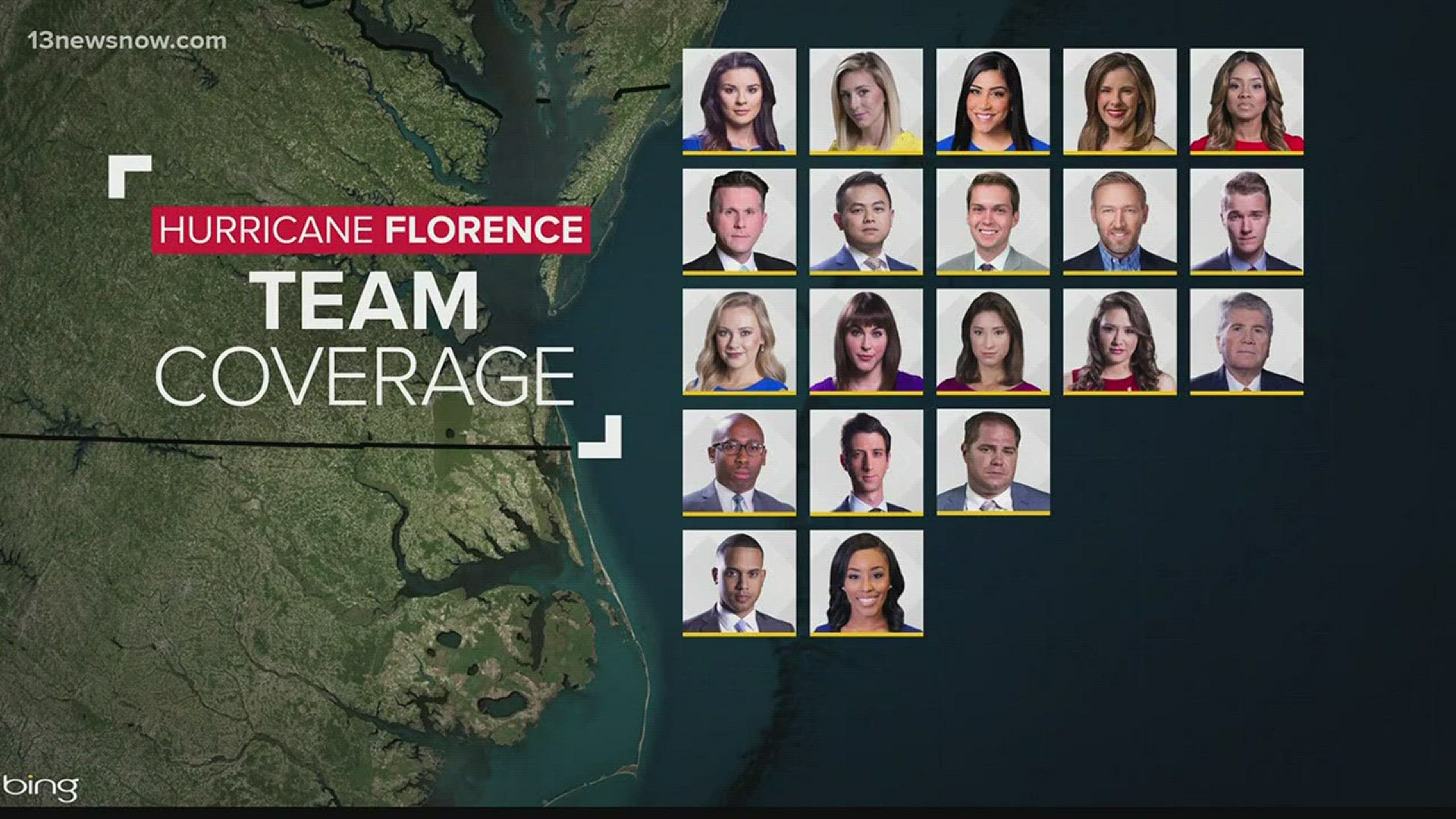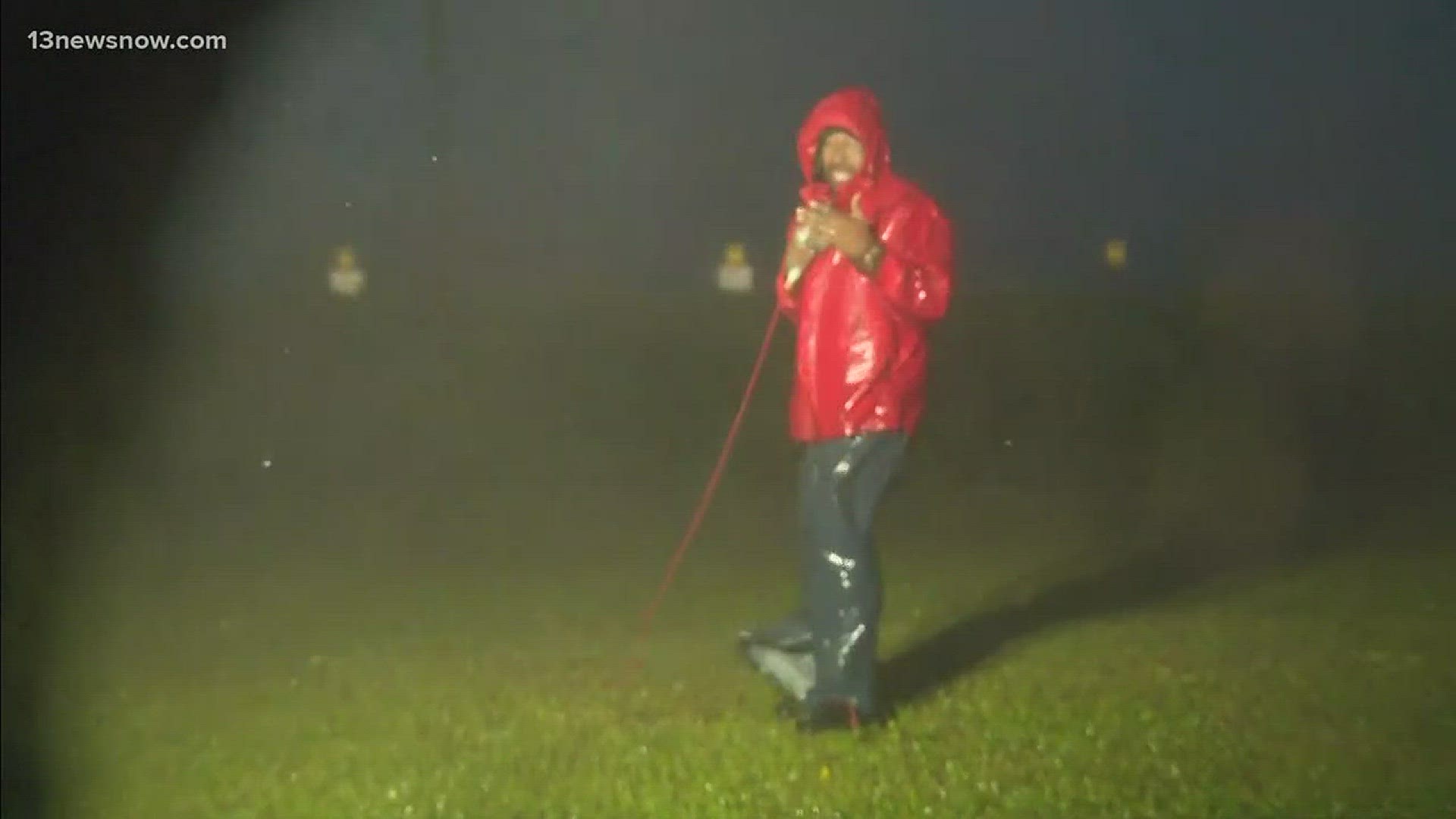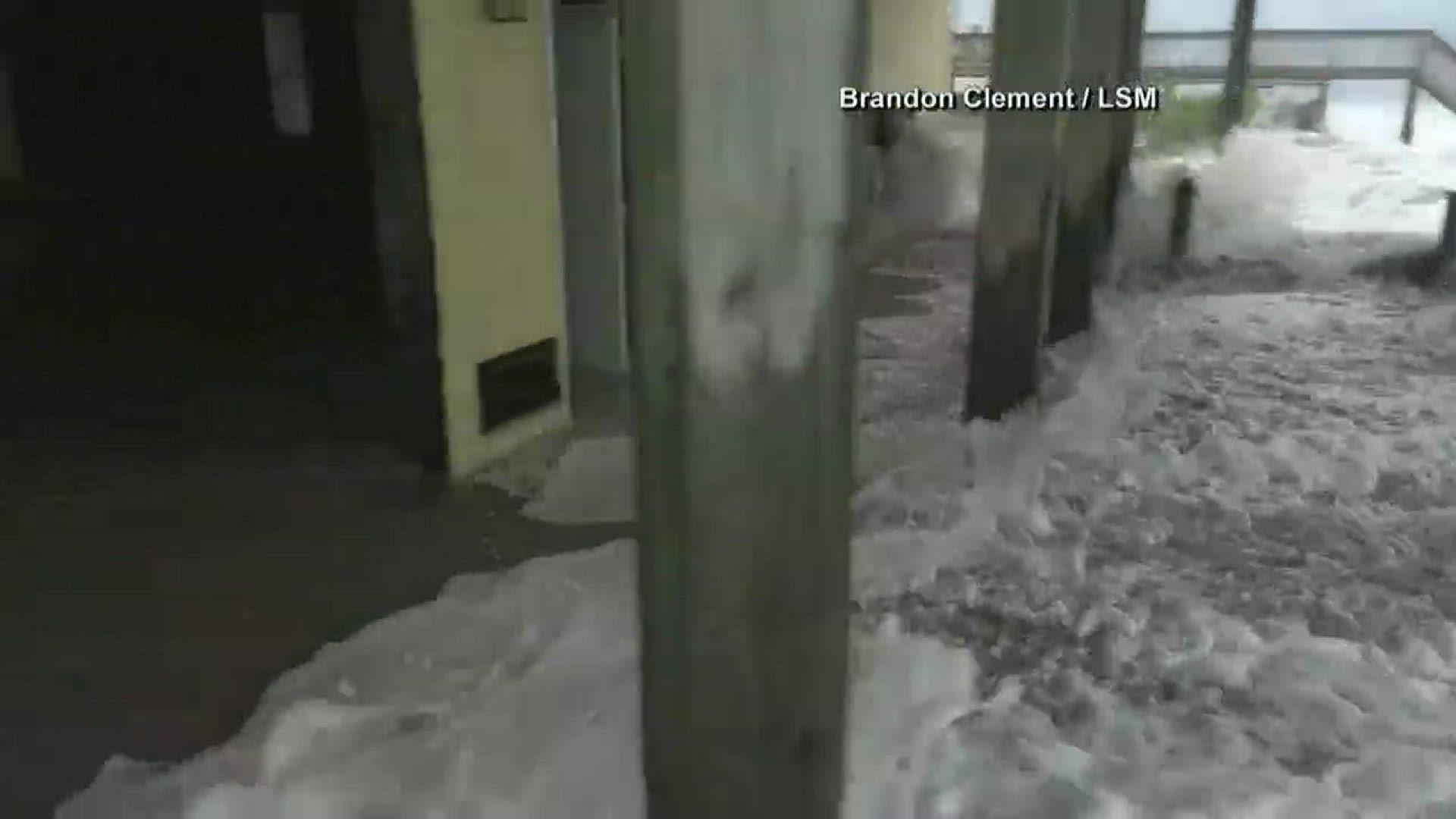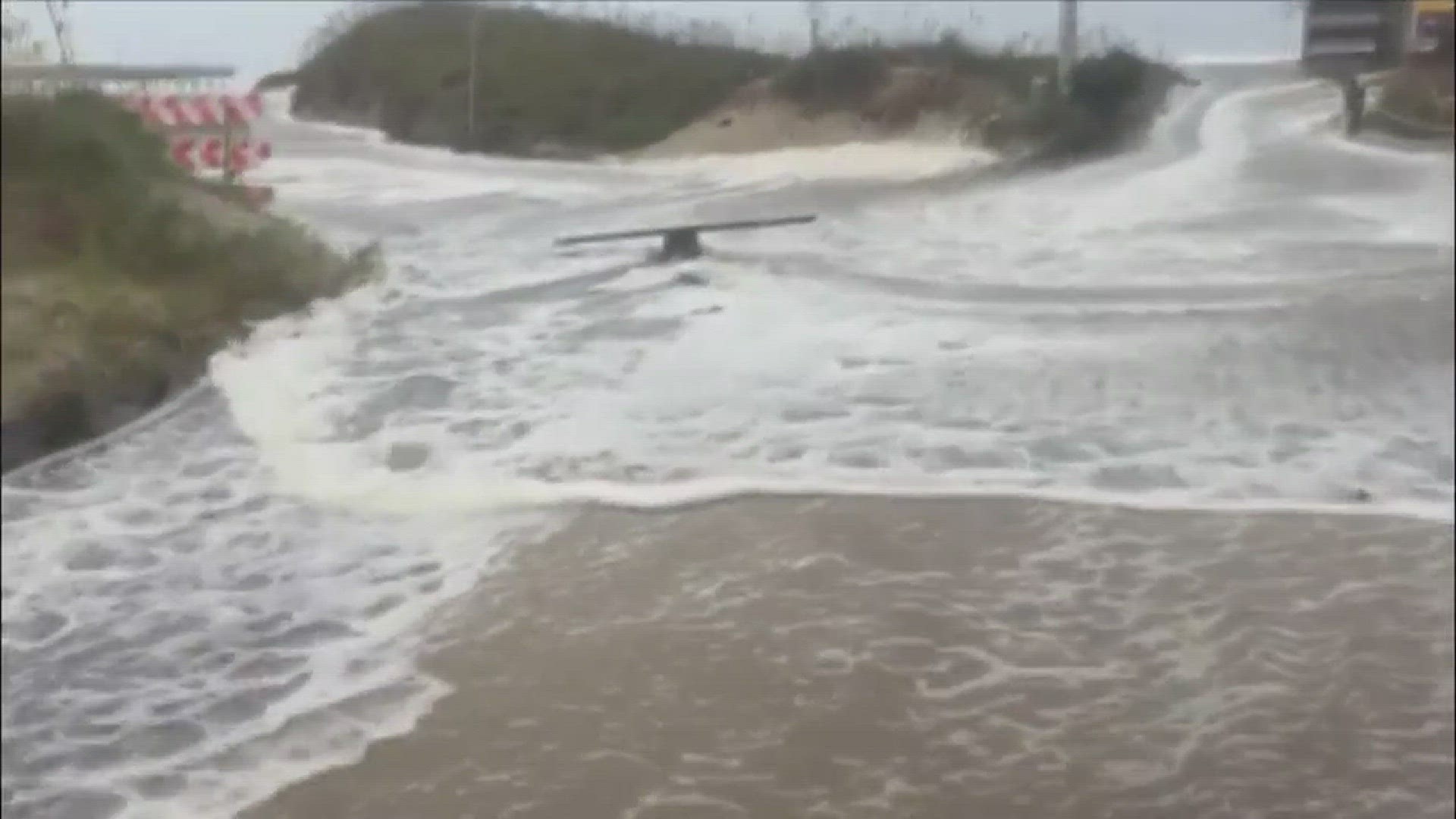Forecasters say Florence is now a tropical storm but will continue to threaten North and South Carolina with powerful winds and catastrophic freshwater flooding.
Its top sustained winds have dropped to 70 mph (110 kph), and it's at a near standstill, moving west at just 3 mph (6 kph).
At 5 p.m., Florence was centered about 50 miles (75 kilometers) west-southwest of Wilmington, North Carolina, and about 25 miles (45 kilometers) northeast of Myrtle Beach, South Carolina.
Tropical storm-force winds extend outward up to 175 miles (280 kilometers) from its center. The National Hurricane Center says Florence is producing tropical storm-force wind gusts in Florence, South Carolina, about 60 miles from the coast.
The storm made landfall Friday in North Carolina, bringing punishing winds, heavy rain and record flooding that drove some residents to seek shelter in attics or upper floors of homes.
In the first report of storm-related fatalities, a mother and infant died after a tree fell on a house in Wilmington, North Carolina, according to local police. The father was hospitalized with injuries.
In addition, a woman in Hampstead suffered a heart attack Friday morning, but emergency crews could not reach her before she died because of downed trees in the road, according to Tom Collins, Director of Emergency Management.
There have been two fatalities in Kinston as a result of Florence, according to Lenoir County Emergency Services Director Roger Dail.
A 78-year-old man was electrocuted at a residence on Silver Smith Circle Friday morning when he was trying to connect two extension cords outside in the rain. His body was discovered by family members.
A 77-year-old man was found dead at 8 a.m. Friday by his family at his home on Middle Street in Kinston. Officials believe he was blown down by the wind when he went out to check on his hunting dogs.
FULL COVERAGE: 13News Now's Hurricane Center
As the storm moves inland, forecasters warned, the surge could cover all but a sliver of the Carolina coast under as much as 11 feet of ocean water, and days of downpours could unload more than 3 feet of rain, touching off severe flooding.
The National Weather Service says 14 to 15 inches of rain has already fallen north of Swansboro, North Carolina.
North Carolina Gov. Roy Cooper said the storm was “wreaking havoc” on the coast and could wipe out entire communities as it makes its “violent grind across our state for days.” He called the rain an event that comes along only once every 1,000 years.
Director Tom Collins says the woman in Hampstead had a heart attack Friday morning, but emergency crews could not get to her because of downed trees in the road. Collins says they have a front loader they're using to clear the roads, but a tree went through the windshield of it.
In New Bern, North Carolina, where the Neuse and Trent rivers intersect, around 200 people were rescued after being stranded in their homes overnight, according to Mayor Dana Outlaw. Another 150, including some trapped in second floors of houses or in attics, awaited rescue.
"What happens is that we rescue some people and then we find out there are still more who need it," Outlaw said. "People who live in New Bern have experienced hurricanes before, but it has been a long time since we have experienced something like this."
The mayor said at least 4,200 homes and 300 businesses sustained damage from flooding.
"Things here are very, very serious," he said. "If you've ever doubted the destructiveness of a hurricane, what's happening here will make you a believer."
Authorities advised residents who have not evacuated to go to the highest point in their homes, call 911 for help, keep their cell batteries charged as best they can and wait for help to arrive.
More than 60 people, including an infant, children and their pets, were rescued from a collapsing hotel in Jacksonville, North Carolina, at the height of the storm, according to the Associated Press.
Cinder blocks that were part of the structure crumbled in some places and portions of the roof were missing. Police and fire teams forced their way into some rooms to free the residents, who were temporarily taken to the town's center for public safety.
About 9,700 National Guard troops and civilians have been deployed, with high-water vehicles, helicopters and boats.
At 2 p.m. EDT, Florence, weakening as it moves inland at 5 mph, was 35 miles west-southwest of Wilmington and 35 miles east-northeast of Myrtle Beach, South Carolina, packing sustained hurricane-force winds of 75 mph, the National Hurricane Center said.
More than 650,000 customers were without power in the Carolinas as the eye of Florence went ashore near Wilmington and began its slow trek along the coast, according to poweroutage.us.
National Weather Service forecasters said the storm would roam along the coast for at least two more days before reaching Columbia, South Carolina, early Sunday. It was also expected to slip briefly back into the open water during the journey.
"This storm will be a marathon vs. a sprint," the National Weather Service said on Twitter. "In addition to the ongoing, dangerous storm surge and flash flooding, will be a long-term river flood threat WELL INLAND as very heavy rainfall continues to fall in the coming days."'
The NHC said Florence went ashore near Wrightsville Beach, North Carolina, at 7:15 a.m. EDT with estimated maximum winds of 90 mph. Shortly afterward, the National Weather Service reported wind gusts to 105 mph at Wilmington International Airport, the highest wind gust measured in Wilmington since Hurricane Helene hit the port city in 1958.
The center said the water level could hit from 7 to 10 feet from Cape Fear to Cape Lookout, North Carolina, and from 6 to 9 feet from Cape Lookout to Ocracoke Inlet.
Even with the storm raging, the Army Corps of Engineers prepared to start work to restore power, install temporary roofing and remove debris.
While thousands chose to flee the coast, others hunkered down. Gigi Charlebois, owner of the Edenton Coffee House on the northern shore of North Carolina's Albemarle Sound, decided to stay with her family overnight in the shop's dining room, sleeping on couches, pull-out cots and a mattress.
She said the shop, with an electric generator, was safer than their nearby home.
“It’s unsafe, a lot of trees,” Charlebois said. “So, even if it was just a tropical storm and trees went down we’d have a hard time getting here.”
Staying there also allowed her to keep an eye on their freezers and fridges holding food. Plus, they’d be there in the morning if first responders needed them.
“That’s why we opened an hour later, because we had to clean up all our bedding,” Charlebois said while standing in the dining room, which by Friday morning teemed with customers while rain poured outside.
The National Hurricane Center said the storm would move further inland across extreme southeastern North Carolina and extreme eastern South Carolina on Friday and Saturday. Florence will then move generally northward across the western Carolinas and the central Appalachian Mountains early next week.
___
Associated Press writers Seth Borenstein in Washington; Jeffrey Collins in Myrtle Beach, South Carolina; Jennifer Kay in Miami; Gary Robertson in Raleigh, North Carolina; Sarah Rankin and Denise Lavoie in Richmond, Virginia; Meg Kinnard in Columbia, South Carolina; Skip Foreman in Charlotte, North Carolina; Jeff Martin in Hampton, Georgia; David Koenig in Dallas; Gerry Broome at Nags Head, North Carolina; and Jay Reeves in Atlanta contributed to this report.




